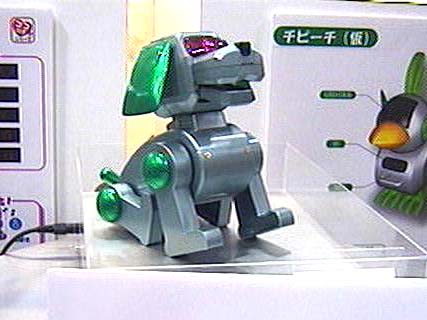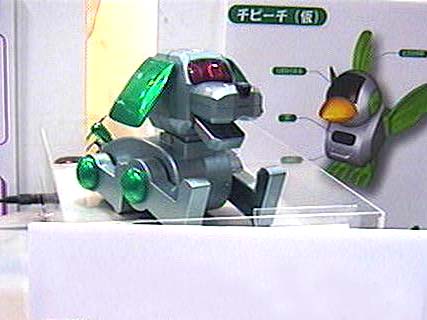AI Poo-Chi

AI Poo-Chi (AIプーチ) was an unreleased version of Poo-Chi that was showcased at the Tokyo Toyfair by SEGA Toys in 2000. It was developed in a joint project with the Massachusetts Institution of Technology (MIT), and it was planned to have been released in October that year for 5980 yen.
Note: Keep in mind that Super Poo-Chi was not present at this event. AI Poo-Chi and Super Poo-Chi have a VERY similar appearance and their interactive features (being able to name it and give voice commands) are the same. They both have the same type of outcomes once they have fully matured, too. While no official sources confirm it, since it has so much in common with Super Poo-Chi, I believe AI Poo-Chi is a prototype version of Super Poo-Chi.
Appearance


AI Poo-Chi is only known to have been made in a color scheme with gray and its main color (legs, body, muzzle, and head) and green as its secondary color (leg caps, tail, and ears). The shape of the tail's end is similar to the original Poo-Chi's tail end.
Functionality
AI Poo-Chi has voice recognition and makes use of its "AI function" to "mature", when you play with it and award it with praise when it correctly obeys your commands. It will respond to commands in Japanese, such as "hand" ("お手" or "o-te" in romaji) and "lie down" ("ふせ" or "fuse" in romaji), and depending on how the owner treats AI Poo-Chi, their robot dog will mature into either of the three levels:
- 野犬レベル (Yaken Inu Reberu/Stray Dog Level) — Poo-Chi won't listen to your commands and will just sleep.
- 忠犬レベル (Chuuken Inu Reberu/Loyal Dog Level) — Poo-Chi obeys you.
- 芸犬レベル (Gei Inu Reberu/Performance Dog Level) — Poo-Chi will sing and dance.
A Yet-To-Be-Added Button
While the prototype pictured on this page doesn't have a button, according to ASCII.jp's article, AI Poo-Chi was to eventually be equipped with a button, allowing you to register its name, so if you call your AI Poo-Chi by its name, it would respond.
Super Poo-Chi, which was released, has two buttons which are used to change the play modes and let him know if he has correctly obeyed a command during training sessions. However, registering Super Poo-Chi's name would require you to tell your Poo-Chi its name.
Links
- Robope's webpage with toyfair photos (shoutout to them for archiving photos of PC & AI Poo-Chi!)
- A watch.impress article briefly mentioning AI Poo-Chi
- An ASCII article with most of the information about AI Poo-Chi
- An ASCII article mentioning AI Poo-Chi briefly
